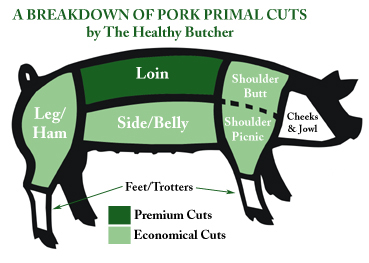
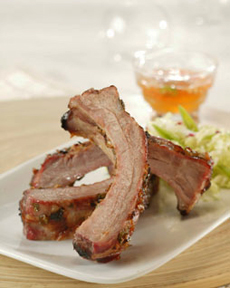 Baby back ribs with an Asian flair. Photo courtesy National Pork Board. Baby back ribs with an Asian flair. Photo courtesy National Pork Board.
April 2010
Last Updated July 2012
|
 |
Pork Cuts & Pork Cuts Chart
Pork Glossary Page 2: Baby Back Ribs & Other Pork Cut Types & Products With A & B
This is Page 2 of a nine-page article, including terms such as Andouille sausage, baby back ribs, bacon, barbecue and Berkshire pork. Click on the black links below to visit other pages. See our many other food glossaries.
This glossary is protected by copyright and cannot be copied in whole or in part.
You are welcome to link to it.
Chart courtesy TheHealthyButcher.com. For a more detailed chart, see Page 1.
ANDOUILLE and ANDOUILLETTE SAUSAGE
Andouille (pronounced on-DWEE) is a heavily smoked, spicy sausage. It is a coarse-grained sausage made with pork, pepper, onions, wine and other seasonings. Although French in origin, the sausage was brought to Louisiana by French immigrants. It is most often associated with Cajun cooking. Andouille sausages are sometimes referred to as “hot link” sausages. Not to be confused with andouillette, a smaller version of the andouille sausage (generally smaller than one inch in diameter, made with coarse-grained smoked tripe sausage made with pork chitterlings, pepper, wine, onions and seasonings).
|
|
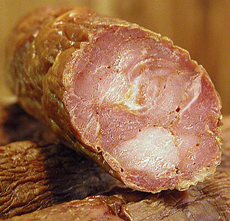
Andouille sausage. Photo by Eva K | Wikimedia Commons.
|
BABY BACK RIBS or BACK RIBS or LOIN RIBS or CANADIAN BACK RIBS
Baby back ribs are taken from the top of the rib cage between the spine and the spare ribs, below the loin muscle. They are the “connoisseur’s ribs”: Cut from the rib section of the loin of pork, there is a good amount of “finger meat” connecting each rib, and the meat is tender, flavorful and succulent. The tenderness allows them to be cooked more quickly than other styles of ribs. In addition to the finger meat, there is meat on top of the bones. The ribs are shorter and curved, and often meatier than regular spare ribs. The rack is shorter at one end, due to the natural tapering of a pig's rib cage, and range from about 3 inches (7.6 cm) to 6 inches (15 cm) in length, depending on the size of the hog.
|
|
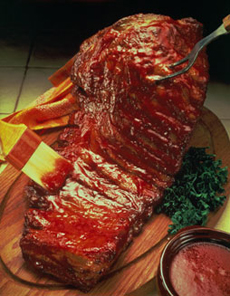
Barbecue spareribs: an American favorite. Photo courtesy National Pork Board.
|
A pig’s side has 15 to 16 ribs (depending on the breed), but usually two or three are left on the shoulder when it is separated from the loin. So a rack of back ribs can contain 8 to 13 ribs, depending on how it has been prepared by the butcher. A typical rack has 10-13 bones.
|
BACK BACON
See Canadian bacon.
BACK FAT
See fatback.
BACK RIBS
See baby back ribs, above.
BACON
Bacon can come from two place on the pig. American, English and Italian bacon come from the belly of the pig while Canadian bacon and Irish bacon come from the back. When the meat is cured and smoked, it becomes bacon. The meat is cured in a brine, a heavily salted water that gives the bacon its saltiness. The fresh-cured bacon may then be cold-air dried, boiled or smoked. An abundance of fat gives bacon its sweet flavor and tender crispiness (belly bacon has more fat than back bacon).
|
|
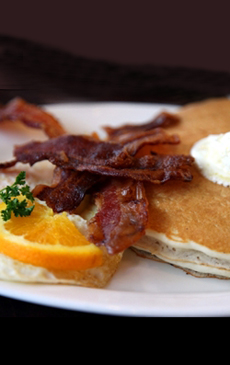
Top-quality bacon from Niman Ranch. Photo courtesy Niman Ranch. |
BACON BITS
Crisp pieces of bacon that are minced for recipes. Real bacon bits must be refrigerated. There are also imitation bacon bits, bacon flavored vegetable protein that is a vegetarian product.
BACON GREASE or BACON DRIPPINGS
Bacon grease is the fat rendered from cooked bacon and used as a cooking fat (use it to cook potatoes or eggs, or in a dressing for potato salad or spinach salad, to flavor beans, cabbage, brussels sprouts and dozens of other dishes). It should be poured into a jar and kept in the refrigerator until needed: Use a coffee filter to catch the solid bits which can turn rancid over time. Or, if the purpose is to discard the fat, keep the jar at room temperature and discard when full.
BACON PIGS & LARD PIGS
Traditionally, pigs have been bred under two main classifications: lard pigs and bacon pigs. Lard pigs are generally thicker with short legs and are fattened quickly on a corn diet. This results in very fatty meat good for making lard and mechanical lubricants (hence the name “lard pig”). Bacon pigs are leaner and more muscular. They are fed a diet of legumes, small grains and turnips, resulting in a slowly grown, leaner pig. Today’s food pigs are much leaner than they were a generation ago, bred to meet America’s desire for a healthier, less fatty meat. Some will remember the advertising campaign that announced that pork was now “the other white meat.”
BARBECUE or BARBEQUE or BBQ
Barbecue refers to a method of cooking apparatus for cooking meat with heat from hot smoke from smoking wood, charcoal or gas. This may include the application of a marinade, spice rub or basting sauce to the meat. As a noun, the term can refer to the meat, the cooking apparatus itself or even to a party that includes such food. As a verb, it refers to the act of cooking food in this manner. Any meat can be barbecued. See our article on The Basics Of Barbecue.
BELLY or PORK BELLY
The belly is a fatty part of the pig that is often cured and smoked to make American bacon. If cured but un-smoked, it is what we know as pancetta. Because there is a lot of collagen, slow methods of cooking are used. Slow roasting at low temperatures and braising are the best ways to handle this piece of meat. Spare ribs and bacon come from the belly.
|
BERKSHIRE PORK or KUROBUTA
PORK
The Berkshire pig was supposedly discovered by Oliver Cromwell’s army in Berkshire, England. It was the favored breed of the English royalty; a large herd was kept at Windsor Castle, and the strains now found in Japan’s Kurobuta pigs trace back to a gift from English royals. The highly-marbled Berkshire pork is famous for its taste: a sweet, rich flavor with a delicate texture and extremely high level of juiciness. Berkshires are medium-size hogs, characteristically black with white feet and a white circle around the snout on a “dished” (pug) face. The breed has a medium snout and erect ears. See heritage pork.
|
|
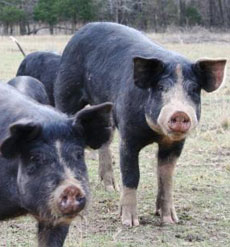
The Berkshire or Kurobuta pig. Photo courtesy DWFarms.com. |
BOCKWURST
Bockwurst is a German sausage invented in 1889. It is one of the most popular varieties of sausage in Germany. The sausage is traditionally made from ground veal and pork (leaning more toward veal, unlike bratwurst). In modern Germany, however, it is made from different types of ground meat, such as pork, lamb, turkey, chicken and in rare cases even from horse. (In northern Germany there is a version of bockwurst that is made from fish!) Bockwurst is flavored with salt, white pepper, paprika and herbs such as chives and parsley.
BONELESS CENTER CUT PORK ROAST
See pork roast.
BRAISING
Braising is a slow cooking method in which tough cuts of meat are slowly simmered in liquid (water, stock or broth) for long periods of time to break down the connective tissue. As a result, the broken down collagen melts into the meat, moistening it and allowing it to become fork tender, such as in a stew.
BRATWURST
Bratwurst is a regional, German sausage usually composed of veal, pork or beef. Bratwurst are usually grilled or steamed in broth or beer, and are popularly served with beer (“brats and beer”), a ballpark favorite. The name is German, deriving from brät, finely chopped meat, and wurst, sausage. The term is often misconstrued to be derived from the German verb braten, which means to pan fry or roast.
BOSTON BUTT
See pork butt.
BOSTON SHOULDER ROAST &
BONELESS BOSTON SHOULDER ROAST
See pork butt.
|
|
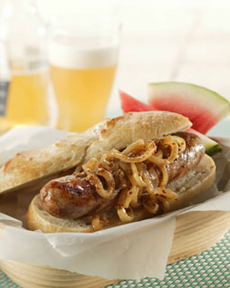
A party favorite: bratwurst and beer. Photo courtesy National Pork Board.
|
BUTCHERING
Butchering refers to breaking an animal down into smaller pieces and parts. When a hog is slaughtered, it is generally split down its backbone, creating two identical halves. It is then further broken down into its primal cuts: the shoulder, the belly (or side), the loin and the hams are among the most popular. See fabrication.
Continue To Page 3: Pork Definitions With C
Go To The Article Index Above
Lifestyle Direct, Inc. All rights reserved. Photos are the copyright of their respective owners.

|



